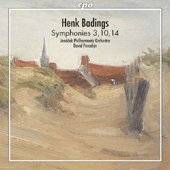
DEFINITIVE RECORDINGS

This, the Symphony No. 3, composed in 1934, is the work that finally diverted the world's attention and focused it on Dutch composer Henk Badings
(1907-1987). And no wonder. It is a formidable symphony. It's opening statement alone, within 45 seconds, has more to say than whole symphonies lasting an hour.
It contains one of those pregnant themes just full of potential and ripe with possibilities. And Henk Badings takes full advantage of it and builds a powerhouse symphonic
work around it. He worked as an engineer until 1937, when he decided to give all that up to devote his life to music, but I believe his technical mind left its mark on his
music. Even though his harmonic language is well advanced, (he researched and used unusual scales and harmonies, sometimes dividing each tone into five micro tones,
used the octatonic scale, and even dabbled in electronic and computer generated music) the form and structure of most of his symphonic works is of a neo-classical
nature. Everything in its place and a place for everything. At any given moment the music's counterpoint becomes quite involved with multiple motifs and subjects
fighting for position, but his firm grasp of structure and forward looking concept keeps everything moving along to attain some wonderful results. The individual
movements might be short, but they all contain lots of fertile musical and emotional material. Not bad for a man who, besides some advice and guidance as to orchestration,
was musically autodidact. This symphony was premiered in May of 1935 by the Concertgebouw Orchestra under Willem Mengelberg. The booklet notes describe the Adagio
movement as being "resigned, elegiac, often of burning tragedy" and the final Allegro assai as being "powerfully, manfully, and intensely
charged." It is a work full of contrasts, bustling with contrapuntal activity and creative energy.
The Symphony No. 10 from 1961, begins the same way. A potent main subject full of development potential sets the tone for the whole symphony. It
gets tossed around from instrument group to instrument group, all the while being supported and moved along by various sub-themes sprouting from various sections of
the orchestra. The second Scherzo movement becomes a double fugue full of creative activity. Again the slow movement creates a dramatic contrast with its
dark beauty. The finale, although short, is an intense affair that moves along like a well-oiled machine with an ending you won't soon forget.
His last symphony, the Symphony No. 14 ("The Flemish"), also subtitled Symphonic Triptych (Slow-Fast-Slow) written in 1968, is quite different. By
now, the air has rarified, the orchestral fabric is less plush, the ideas are more focused and the harmonic language is quite evolved. The first movement slowly intoduces
the work's concept which gradually leads into a middle movement full of nervous and frenetic energy that builds to a powerful and intense climax. The third and final
movement is very strange. It brings to mind the 'Neptune' segment of Gustav Holst's Planets. The instrumentation consists mostly of strings, celesta and vibraphone. The
music is very calm and formless, even mysterious. At the very end, the strings ascend slowly upwards and eventually seem to fade away and vanish in the distance. Even
in this type of writing, you can feel the composer's clever manipulation always at work. Fascinating music!
If their names were not listed anywhere on the packaging, you would swear that you are listening to a major, well-established orchestra under a big-name conductor with
a "Sir" in front of his name. That's because the Janacek Philharmonic Orchestra with David Porcelijn on the podium are amazing
in this music. They are convinced this is great music and are commited to convince us that this is great music. The playing throughout is top-notch and is matched by a
great recording. Again CPO are to be applauded for taking on the major task of recording all of this neglected composer's orchestral works. This is the
second in a series of recordings that will set standards.
Jean-Yves Duperron - July 2010